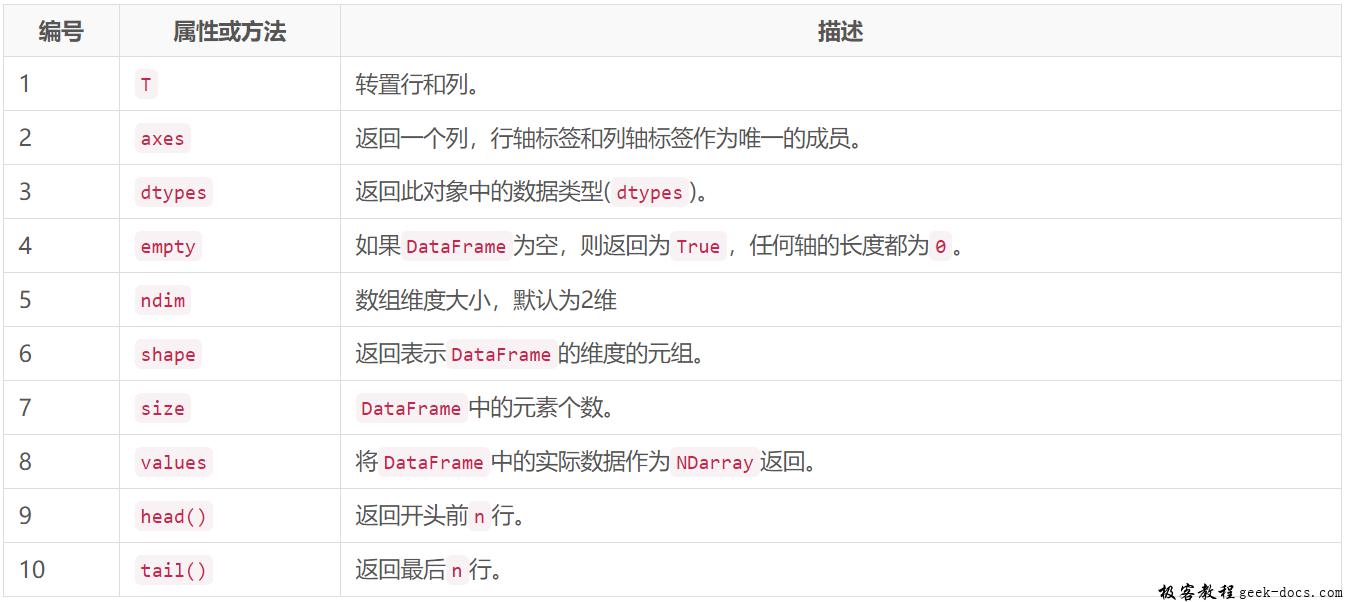DataFrame 基本属性和方法,前面介绍了创建DataFrame和DataFrame的基本用法,下面来看看数据帧(DataFrame)的基本功能有哪些?下表列出了DataFrame的重要属性和方法。

下面来看看如何创建一个DataFrame并使用上述属性和方法。
import pandas as pd
import numpy as np
#Create a Dictionary of series
d = {'Name':pd.Series(['Tom','James','Ricky','Vin','Steve','Minsu','Jack']),
'Age':pd.Series([25,26,25,23,30,29,23]),
'Rating':pd.Series([4.23,3.24,3.98,2.56,3.20,4.6,3.8])}
#Create a DataFrame
df = pd.DataFrame(d)
print ("Our data series is:")
print (df)
执行结果如下:
Our data series is:
Age Name Rating
0 25 Tom 4.23
1 26 James 3.24
2 25 Ricky 3.98
3 23 Vin 2.56
4 30 Steve 3.20
5 29 Minsu 4.60
6 23 Jack 3.80
T (转置)示例
返回DataFrame的转置,行和列将交换。示例代码如下:
import pandas as pd
import numpy as np
# Create a Dictionary of series
d = {'Name':pd.Series(['Tom','James','Ricky','Vin','Steve','Minsu','Jack']),
'Age':pd.Series([25,26,25,23,30,29,23]),
'Rating':pd.Series([4.23,3.24,3.98,2.56,3.20,4.6,3.8])}
# Create a DataFrame
df = pd.DataFrame(d)
print ("The transpose of the data series is:")
print (df.T)
执行结果如下:
The transpose of the data series is:
0 1 2 3 4 5 6
Age 25 26 25 23 30 29 23
Name Tom James Ricky Vin Steve Minsu Jack
Rating 4.23 3.24 3.98 2.56 3.2 4.6 3.8
axes 示例
返回行轴标签和列轴标签列表,示例代码如下:
import pandas as pd
import numpy as np
#Create a Dictionary of series
d = {'Name':pd.Series(['Tom','James','Ricky','Vin','Steve','Minsu','Jack']),
'Age':pd.Series([25,26,25,23,30,29,23]),
'Rating':pd.Series([4.23,3.24,3.98,2.56,3.20,4.6,3.8])}
#Create a DataFrame
df = pd.DataFrame(d)
print ("Row axis labels and column axis labels are:")
print (df.axes)
执行结果如下:
Row axis labels and column axis labels are:
[RangeIndex(start=0, stop=7, step=1), Index(['Age', 'Name', 'Rating'], dtype='object')]
dtypes 示例
返回每列的数据类型。示例代码如下:
import pandas as pd
import numpy as np
#Create a Dictionary of series
d = {'Name':pd.Series(['Tom','James','Ricky','Vin','Steve','Minsu','Jack']),
'Age':pd.Series([25,26,25,23,30,29,23]),
'Rating':pd.Series([4.23,3.24,3.98,2.56,3.20,4.6,3.8])}
#Create a DataFrame
df = pd.DataFrame(d)
print ("The data types of each column are:")
print (df.dtypes)
执行结果如下:
The data types of each column are:
Age int64
Name object
Rating float64
dtype: object
empty 示例
返回布尔值,表示对象是否为空, 返回True表示对象为空。示例代码如下:
import pandas as pd
import numpy as np
#Create a Dictionary of series
d = {'Name':pd.Series(['Tom','James','Ricky','Vin','Steve','Minsu','Jack']),
'Age':pd.Series([25,26,25,23,30,29,23]),
'Rating':pd.Series([4.23,3.24,3.98,2.56,3.20,4.6,3.8])}
#Create a DataFrame
df = pd.DataFrame(d)
print ("Is the object empty?")
print (df.empty)
执行结果如下:
Is the object empty?
False
ndim 示例
返回对象的维数。根据定义,DataFrame是一个2D对象。示例代码如下:
import pandas as pd
import numpy as np
#Create a Dictionary of series
d = {'Name':pd.Series(['Tom','James','Ricky','Vin','Steve','Minsu','Jack']),
'Age':pd.Series([25,26,25,23,30,29,23]),
'Rating':pd.Series([4.23,3.24,3.98,2.56,3.20,4.6,3.8])}
#Create a DataFrame
df = pd.DataFrame(d)
print ("Our object is:")
print (df)
print ("The dimension of the object is:")
print (df.ndim)
执行结果如下:
Our object is:
Age Name Rating
0 25 Tom 4.23
1 26 James 3.24
2 25 Ricky 3.98
3 23 Vin 2.56
4 30 Steve 3.20
5 29 Minsu 4.60
6 23 Jack 3.80
The dimension of the object is:
2
shape 示例
返回表示DataFrame的维度的元组。 元组(a,b),其中a表示行数,b表示列数。示例代码如下:
import pandas as pd
import numpy as np
#Create a Dictionary of series
d = {'Name':pd.Series(['Tom','James','Ricky','Vin','Steve','Minsu','Jack']),
'Age':pd.Series([25,26,25,23,30,29,23]),
'Rating':pd.Series([4.23,3.24,3.98,2.56,3.20,4.6,3.8])}
#Create a DataFrame
df = pd.DataFrame(d)
print ("Our object is:")
print (df)
print ("The shape of the object is:")
print (df.shape)
执行结果如下:
Our object is:
Age Name Rating
0 25 Tom 4.23
1 26 James 3.24
2 25 Ricky 3.98
3 23 Vin 2.56
4 30 Steve 3.20
5 29 Minsu 4.60
6 23 Jack 3.80
The shape of the object is:
(7, 3)
size 示例
返回 DataFrame 中的元素个数。示例代码如下:
import pandas as pd
import numpy as np
#Create a Dictionary of series
d = {'Name':pd.Series(['Tom','James','Ricky','Vin','Steve','Minsu','Jack']),
'Age':pd.Series([25,26,25,23,30,29,23]),
'Rating':pd.Series([4.23,3.24,3.98,2.56,3.20,4.6,3.8])}
#Create a DataFrame
df = pd.DataFrame(d)
print ("Our object is:")
print (df)
print ("The total number of elements in our object is:")
print (df.size)
执行结果如下:
Our object is:
Age Name Rating
0 25 Tom 4.23
1 26 James 3.24
2 25 Ricky 3.98
3 23 Vin 2.56
4 30 Steve 3.20
5 29 Minsu 4.60
6 23 Jack 3.80
The total number of elements in our object is:
21
values 示例
将DataFrame中的实际数据作为NDarray返回。示例代码如下:
import pandas as pd
import numpy as np
#Create a Dictionary of series
d = {'Name':pd.Series(['Tom','James','Ricky','Vin','Steve','Minsu','Jack']),
'Age':pd.Series([25,26,25,23,30,29,23]),
'Rating':pd.Series([4.23,3.24,3.98,2.56,3.20,4.6,3.8])}
#Create a DataFrame
df = pd.DataFrame(d)
print ("Our object is:")
print (df)
print ("The actual data in our data frame is:")
print (df.values)
执行结果如下:
Our object is:
Age Name Rating
0 25 Tom 4.23
1 26 James 3.24
2 25 Ricky 3.98
3 23 Vin 2.56
4 30 Steve 3.20
5 29 Minsu 4.60
6 23 Jack 3.80
The actual data in our data frame is:
[[25 'Tom' 4.23]
[26 'James' 3.24]
[25 'Ricky' 3.98]
[23 'Vin' 2.56]
[30 'Steve' 3.2]
[29 'Minsu' 4.6]
[23 'Jack' 3.8]]
head() 和 tail() 示例
要查看DataFrame对象的小样本,可使用head()和tail()方法。head()返回前n行(观察索引值)。默认数量为5,可以传递自定义数值。
import pandas as pd
import numpy as np
#Create a Dictionary of series
d = {'Name':pd.Series(['Tom','James','Ricky','Vin','Steve','Minsu','Jack']),
'Age':pd.Series([25,26,25,23,30,29,23]),
'Rating':pd.Series([4.23,3.24,3.98,2.56,3.20,4.6,3.8])}
#Create a DataFrame
df = pd.DataFrame(d)
print ("Our data frame is:")
print (df)
print ("The first two rows of the data frame is:")
print (df.head(2))
执行结果如下:
Our data frame is:
Age Name Rating
0 25 Tom 4.23
1 26 James 3.24
2 25 Ricky 3.98
3 23 Vin 2.56
4 30 Steve 3.20
5 29 Minsu 4.60
6 23 Jack 3.80
The first two rows of the data frame is:
Age Name Rating
0 25 Tom 4.23
1 26 James 3.24
tail()返回最后n行(观察索引值)。默认数量为5,可以传递自定义数值。
import pandas as pd
import numpy as np
#Create a Dictionary of series
d = {'Name':pd.Series(['Tom','James','Ricky','Vin','Steve','Minsu','Jack']),
'Age':pd.Series([25,26,25,23,30,29,23]),
'Rating':pd.Series([4.23,3.24,3.98,2.56,3.20,4.6,3.8])}
#Create a DataFrame
df = pd.DataFrame(d)
print ("Our data frame is:")
print (df)
print ("The last two rows of the data frame is:")
print (df.tail(2))
执行结果如下:
Our data frame is:
Age Name Rating
0 25 Tom 4.23
1 26 James 3.24
2 25 Ricky 3.98
3 23 Vin 2.56
4 30 Steve 3.20
5 29 Minsu 4.60
6 23 Jack 3.80
The last two rows of the data frame is:
Age Name Rating
5 29 Minsu 4.6
6 23 Jack 3.8
 极客教程
极客教程